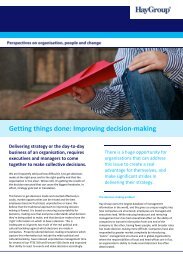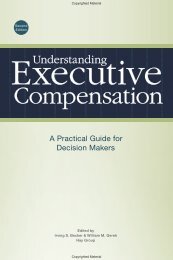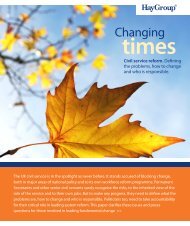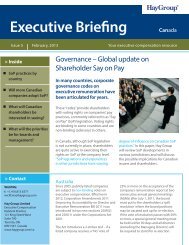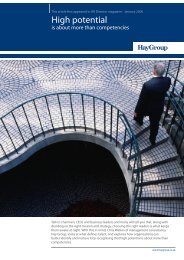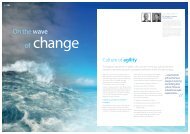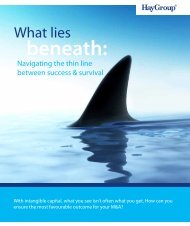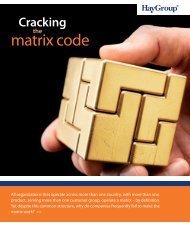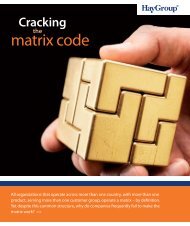Engage Employees and Boost Performance - Hay Group
Engage Employees and Boost Performance - Hay Group
Engage Employees and Boost Performance - Hay Group
You also want an ePaper? Increase the reach of your titles
YUMPU automatically turns print PDFs into web optimized ePapers that Google loves.
The new [employment] contract<br />
says, “We’ll make your job (<strong>and</strong><br />
life) more meaningful. You give<br />
us your hearts <strong>and</strong> minds.”<br />
4<br />
W O R K I N G<br />
PAPER<br />
key player in the company’s turnaround. “Work is a significant part of people’s<br />
lives. When you meet someone new, the second or third question is ‘What do<br />
you do?’ It’s imperative that leaders give people meaning in their work<br />
because passionate employees get better results. If leaders can’t give people<br />
passion about their work, employees will find it somewhere else.”<br />
What engagement looks like<br />
University of Chicago psychologist Mihalyi Csikzentmihalyi, 3 who has studied<br />
the psychology of engaged workers at all levels, found that they create a hyperfocused<br />
state of mind. He calls it “flow.” People in flow are exhilarated <strong>and</strong> are<br />
remarkably unstressed even when doing challenging work. They lose themselves<br />
in a task they love <strong>and</strong> feel “out of time.” Their brains work efficiently<br />
<strong>and</strong> precisely. People are much more likely to be in flow while working than<br />
while involved in leisure activities. Moreover, flow occurs most often when<br />
tasks are tightly aligned with the person’s goals.<br />
What disengagement looks like<br />
At the end of each day union workers at an oil refinery dumped scrap metal in<br />
a pile to be discarded by a night crew. The day crew routinely co-mingled the<br />
scrap with pieces of new steel; as a result the night crew was tossing out the<br />
new steel as well. The practice was costing the company hundreds of dollars a<br />
day. When asked why they were throwing out new steel with scrap, the night<br />
workers replied,“Because we were told to clean up the area.” What they were<br />
doing made no sense, but they felt their duty was to do their job, not to make<br />
sense of things.<br />
“These workers were very smart people,” says a consultant who worked with<br />
the company. “Many of them had their own businesses on the side; one was<br />
the mayor of his town. There was a great deal of ‘discretionary effort’ in this<br />
workforce, <strong>and</strong> the company was getting none of it. One of the workers said<br />
to me,‘Basically, when we come here we check our brains at the gate.’”<br />
Contrast these workers with a payroll clerk at GDDS.<br />
On Tuesday, September 11, 2001, the day of the World Trade Center attack, she<br />
realized that employees weren’t going to get their pay checks on Thursday<br />
3 “Flow: The Psychology of Optimal Experience,” by Mihalyi Csikzentmihalyi. Harper <strong>and</strong> Row,<br />
New York, 1990.



